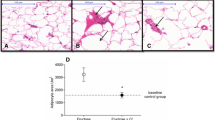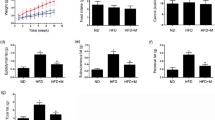Abstract
Background
The inflammatory process associated with obesity mainly arises from white adipose tissue (WAT) alterations. In the last few years, nutritional-based strategies have been positioned as promising alternatives to pharmacological approaches against these pathologies. Our aim was to determine the potential of a rice bran enzymatic extract (RBEE)-supplemented diet in the prevention of metabolic, biochemical and functional adipose tissue and macrophage changes associated with a diet-induced obesity (DIO) in mice.
Methods
C57BL/6J mice were fed high-fat diet (HF), 1 and 5 % RBEE-supplemented high-fat diet (HF1 % and HF5 %, respectively) and standard diet as control. Serum cardiometabolic parameters, adipocytes size and mRNA expression of pro-inflammatory biomarkers and macrophage polarization-related genes from WAT and liver were evaluated.
Results
RBEE administration significantly decreased insulin resistance in obese mice. Serum triglycerides, total cholesterol, glucose, insulin, adiponectin and nitrites from treated mice were partially restored, mainly by 1 % RBEE-enriched diet. The incremented adipocytes size observed in HF group was reduced by RBEE treatment, being 1 % more effective than 5 % RBEE. Pro-inflammatory biomarkers in WAT such as IL-6 and IL-1β were significantly decreased in RBEE-treated mice. Adiponectin, PPARγ, TNF-α, Emr1 or M1/M2 levels were significantly restored in WAT from HF1 % compared to HF mice.
Conclusions
RBEE-supplemented diet attenuated insulin resistance, dyslipidemia and morphological and functional alterations of adipose tissue in DIO mice. These benefits were accompanied by a modulating effect in adipocytes secretion and some biomarkers associated with macrophage polarization. Therefore, RBEE may be considered an alternative nutritional complement over metabolic syndrome and its complications.




Similar content being viewed by others
References
Hossain P, Kawar B, El Nahas M (2007) Obesity and diabetes in the developing world—a growing challenge. N Engl J Med 356(3):213–215
Hotamisligil G, Erbay E (2008) Nutrient sensing and inflammation in metabolic diseases. Nat Rev Immunol 8(12):923–934
Gregor M, Hotamisligil G (2011) Inflammatory mechanisms in obesity. Annu Rev Immunol 29:415–445
Makki K, Froguel P, Wolowczuk I (2013) Adipose tissue in obesity-related inflammation and insulin resistance: cells, cytokines, and chemokines. ISRN Inflamm 2013:139239
Bluher M (2009) Adipose tissue dysfunction in obesity. Exp Clin Endocrinol Diabetes 117(06):241–250
Yang J, Eliasson B, Smith U, Cushman S, Sherman A (2012) The size of large adipose cells is a predictor of insulin resistance in first-degree relatives of type 2 diabetic patients. Obesity 20(5):932–938
Hotamisligil G, Shargill N, Spiegelman B (1993) Adipose expression of tumor necrosis factor-alpha: direct role in obesity-linked insulin resistance. Science 259(5091):87–91
Ndisang J (2010) Role of heme oxygenase in inflammation, insulin-signalling, diabetes and obesity. Mediat Inflamm 2010:359732
Malagón M, Díaz-Ruiz A, Guzmán-Ruíz R, Jimenez-Gómez Y, Moreno NR, Garcia-Navarro S et al (2013) Adipobiology for novel therapeutic approaches in metabolic syndrome. Curr Vasc Pharmacol 11(6):954–967
Lumeng CN, Bodzin JL, Saltiel AR (2007) Obesity induces a phenotypic switch in adipose tissue macrophage polarization. J Clin Invest 117(1):175–184
Odegaard J, Ricardo-Gonzalez R, Goforth M, Morel C, Subramanian V, Mukundan L et al (2007) Macrophage-specific PPARgamma; controls alternative activation and improves insulin resistance. Nature 447(7148):1116–1120
Tontonoz P, Spiegelman B (2008) Fat and beyond: the diverse biology of PPARgamma. Annu Rev Biochem 77:289–312
Islam S, Nagasaka R, Ohara K, Hosoya T, Ozaki H, Ushio H et al (2011) Biological abilities of rice bran-derived antioxidant phytochemicals for medical therapy. Curr Top Med Chem 11(14):1847–1853
Fabian C, Ju Y (2011) A review on rice bran protein: its properties and extraction methods. Crit Rev Food Sci Nutr 51(9):816–827
Parrado J, Miramontes E, Jover M, Gutierrez J, Collantes de Ter’an L, Bautista J (2006) Preparation of a rice bran enzymatic extract with potential use as functional food. Food Chem 98(4):742–748
Park N, Rico C, Lee S, Kang M (2012) Comparative effects of doenjang prepared from soybean and brown rice on the body weight and lipid metabolism in high fat-fed mice. J Clin Biochem Nutr 51(3):235
Dhara R, Dhar P, Ghosh M (2012) Dietary effects of pure and diacylglycerol-rich rice bran oil on growth pattern and lipid profile of rats. J Oleo Sci 61(7):369–375
Misra A, Singhal N, Khurana L (2010) Obesity, the metabolic syndrome, and type 2 diabetes in developing countries: role of dietary fats and oils. J Am Coll Nutr 29(sup3):289–301
Justo M, Rodriguez-Rodriguez R, Claro C, de Sotomayor M, Parrado J, Herrera M (2013) Water-soluble rice bran enzymatic extract attenuates dyslipidemia, hypertension and insulin resistance in obese Zucker rats. Eur J Nutr 52(2):789–797
Justo M, Candiracci M, Dantas A, de Sotomayor M, Parrado J, Vila E et al (2013) Rice bran enzymatic extract restores endothelial function and vascular contractility in obese rats by reducing vascular inflammation and oxidative stress. J Nutr Biochem 24(8):1453–1461
Justo M, Claro C, Vila E, Herrera M, Rodriguez-Rodriguez R (2014) Microvascular disorders in obese Zucker rats are restored by a rice bran diet. Nutr Metab Cardiovasc Dis 24(5):524–531
Candiracci M, Justo M, Castaño A, Rodriguez-Rodriguez R, Herrera M (2014) Rice bran enzymatic extract-supplemented diets modulate adipose tissue inflammation markers in Zucker rats. Nutrition 30(4):466–472
Mingorance C, Sotomayor M, Jimenez-Palacios F, Mochón M, Casto C, Marhuenda E et al (2009) Effects of chronic treatment with the CB1 antagonist, rimonabant on the blood pressure, and vascular reactivity of obese Zucker rats. Obesity 17(7):1340–1347
Rodriguez-Rodriguez R, Herrera M, de Sotomayor M, Ruiz-Gutierrez V (2007) Pomace olive oil improves endothelial function in spontaneously hypertensive rats by increasing endothelial nitric oxide synthase expression. Am J Hypertens 20(7):728–734
Cicero A, Gaddi A (2001) Rice bran oil and gamma-oryzanol in the treatment of hyperlipoproteinaemias and other conditions. Phytother Res 15(4):277–289
Wang Y, Jones P, Pischel I, Fairow C (2003) Effects of policosanols and phytosterols on lipid levels and cholesterol biosynthesis in hamsters. Lipids 38(2):165–170
Wilson T, Nicolosi R, Woolfrey B, Kritchevsky D (2007) Rice bran oil and oryzanol reduce plasma lipid and lipoprotein cholesterol concentrations and aortic cholesterol ester accumulation to a greater extent than ferulic acid in hypercholesterolemic hamsters. J Nutr Biochem 18(2):105–112
Shirakawa H, Koseki T, Hashizume K, Komai M et al (2007) The Driselase-treated fraction of rice bran is a more effective dietary factor to improve hypertension, glucose and lipid metabolism in stroke-prone spontaneously hypertensive rats compared to ferulic acid. Br J Nutr 97(1):67–76
Islam M, Murata T, Fujisawa M, Nagasaka R, Ushio H, Bari A et al (2008) Anti-inflammatory effects of phytosteryl ferulates in colitis induced by dextran sulphate sodium in mice. Br J Pharmacol 154(4):812–824
Manosroi A, Chutoprapat R, Abe M, Manosroi W, Manosroi J (2012) Anti-aging efficacy of topical formulations containing niosomes entrapped with rice bran bioactive compounds. Pharm Biol 50(2):208–224
Kesh S, Sikder K, Manna K, Das D, Khan A, Das N et al (2013) Promising role of ferulic acid, atorvastatin and their combination in ameliorating high fat diet-induced stress in mice. Life Sci 92(17):938–949
Revilla E, Maria C, Miramontes E, Bautista J, García-Martínez A, Cremades O et al (2009) Nutraceutical composition, antioxidant activity and hypocholesterolemic effect of a water-soluble enzymatic extract from rice bran. Food Res Int 42(3):387–393
Minhajuddin M, Beg ZH, Iqbal J (2005) Hypolipidemic and antioxidant properties of tocotrienol rich fraction isolated from rice bran oil in experimentally induced hyperlipidemic rats. Food Chem Toxicol 43:747–753
Qureshi AA, Sami SA, Salser WA, Khan FA (2002) Dose-dependent suppression of serum cholesterol by tocotrienol-rich fraction (TRF25) of rice bran in hypercholesterolemic humans. Atherosclerosis 161:199–207
Odegaard J, Chawla A (2013) Pleiotropic actions of insulin resistance and inflammation in metabolic homeostasis. Science 339(6116):172–177
Waki H, Tontonoz P (2007) Endocrine functions of adipose tissue. Annu Rev Pathol Mech Dis 2:31–56
Tilg H, Moschen A (2008) Inflammatory mechanisms in the regulation of insulin resistance. Mol Med 14(3–4):222
Rotter V, Nagaev I, Smith U (2003) Interleukin-6 (IL-6) induces insulin resistance in 3T3-L1 adipocytes and is, like IL-8 and tumor necrosis factor-alpha, overexpressed in human fat cells from insulin-resistant subjects. J Biol Chem 278(46):45777–45784
Olefsky J, Glass C (2010) Macrophages, inflammation, and insulin resistance. Annu Rev Physiol 72:219–246
Nakatsuji H, Kishida K, Sekimoto R, Komura N, Kihara S, Funahashi T et al (2014) Accumulation of adiponectin in inflamed adipose tissues of obese mice. Metabolism 63(4):542–553
Campbell S, Stone W, Whaley S, Qui M, Krishnan K (2003) Gamma-tocopherol upregulates peroxisome proliferator activated receptor (PPAR)-gamma expression in SW 480 human colon cancer cell lines. BMC Cancer 3(1):25
Ortuño Sahagún D, Márquez-Aguirre A, Quintero-Fabian S, López-Roa R, Rojas-Mayorquín A (2012) Modulation of PPAR-gamma by nutraceutics as complementary treatment for obesity-related disorders and inflammatory diseases. PPAR Res 2012:318613
Westerbacka J, Corner A, Kannisto K, Kolak M, Makkonen J, Korsheninnikova E et al (2006) Acute in vivo effects of insulin on gene expression in adipose tissue in insulin-resistant and insulin-sensitive subjects. Diabetologia 49(1):132–140
Imam M, Ismail M, Ithnin H, Tubesha Z, Omar A (2013) Effects of germinated brown rice and its bioactive compounds on the expression of the peroxisome proliferator-activated receptor gamma gene. Nutrients 5(2):468–477
Ho J, Son M, Lim W, Lim S, Cho H (2013) Germinated brown rice extract inhibits adipogenesis through the down-regulation of adipogenic genes in 3T3-L1 adipocytes. Plant Foods Hum Nutr 68(3):274–278
Acknowledgments
This research was supported by the Spanish Ministry of Science and Innovation (AGL2009-1159). M.L. Justo is a recipient of a FPU Fellowship from the Spanish Government. Part of the experiments showed in this study was made in a short stay supported by the Spanish Government and supervised by the professor Dr. Stulnig and its research group in the Medical University of Vienna (Austria).
Grants, sponsors and funding sources
This research was supported by The Spanish Ministry of Science and Technology (AGL2009-1159). Justo ML has been a recipient of a FPU fellowship from the Spanish Government.
Author information
Authors and Affiliations
Corresponding author
Ethics declarations
Conflict of interest
The authors confirm that this article content has no conflict of interest.
Electronic supplementary material
Below is the link to the electronic supplementary material.
Rights and permissions
About this article
Cite this article
Justo, M.L., Claro, C., Zeyda, M. et al. Rice bran prevents high-fat diet-induced inflammation and macrophage content in adipose tissue. Eur J Nutr 55, 2011–2019 (2016). https://doi.org/10.1007/s00394-015-1015-x
Received:
Accepted:
Published:
Issue Date:
DOI: https://doi.org/10.1007/s00394-015-1015-x




